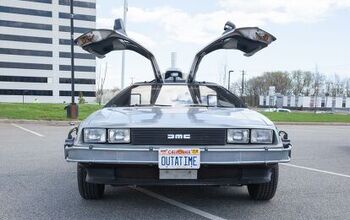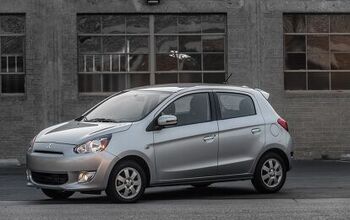QOTD: What Was Peak K-car for You?

It was one of those make or break moments. A company teetering on the financial verge which threw a Hail Mary at the right time — and at the right target. The company in question was Chrysler, and the Hail Mary was the K-car platform.
Today we ask you: What was peak K?
I got to thinking about the K-car recently, both as financial savior and platform-sharing wonder. Among its virtues of affordability and flexibility, there was also an aspect of unfortunate longevity. One basic platform, tons of variants, and a timeline stretching between 1981 and 1995.
To put that in perspective, people drove a new K-platform car to see Raiders of the Lost Ark at the movie theater. They did the same thing in 1995 when they went to see Jumanji, a film which actually featured the final K variant sold — the Chrysler LeBaron (though an older one, which was not great for giant mosquitoes).
In between, just about every body style was covered by the K: sedan, coupe, convertible, hatchback, wagon, limousine. From base wheel covers to, well, brougham wheel covers, models ran the gamut in price. They all had a couple things in common, though: front-drive and a transverse engine. I’ll try and make a platform derivations list below.
- K came first, compacts
- E and H, larger cars in the midsize class
- AG and AJ, sporty driving cars
- S, minivans to 1990
- AS, minivans 1991-1995
- AP, later version for revised compact cars
- AC, later luxury midsize sedans
- AA, later standard midsize sedans
- Q, one-hit wonder for the TC by Maserati
- AY, longest wheelbase luxury sedans
Somewhere in that extensive list there’s undoubtedly a peak vehicle, though you may have to look up which particular version of K resides underneath. Let’s hear ’em.
[Images: IMCDB, Steph Willems/TTAC]

Interested in lots of cars and their various historical contexts. Started writing articles for TTAC in late 2016, when my first posts were QOTDs. From there I started a few new series like Rare Rides, Buy/Drive/Burn, Abandoned History, and most recently Rare Rides Icons. Operating from a home base in Cincinnati, Ohio, a relative auto journalist dead zone. Many of my articles are prompted by something I'll see on social media that sparks my interest and causes me to research. Finding articles and information from the early days of the internet and beyond that covers the little details lost to time: trim packages, color and wheel choices, interior fabrics. Beyond those, I'm fascinated by automotive industry experiments, both failures and successes. Lately I've taken an interest in AI, and generating "what if" type images for car models long dead. Reincarnating a modern Toyota Paseo, Lincoln Mark IX, or Isuzu Trooper through a text prompt is fun. Fun to post them on Twitter too, and watch people overreact. To that end, the social media I use most is Twitter, @CoreyLewis86. I also contribute pieces for Forbes Wheels and Forbes Home.
More by Corey Lewis
Latest Car Reviews
Read moreLatest Product Reviews
Read moreRecent Comments
- ToolGuy Please allow me to listen to the podcast before commenting. (This is the way my mind works, please forgive me.)
- ToolGuy My ancient sedan (19 years lol) matches the turbo Mazda 0-60 (on paper) while delivering better highway fuel economy, so let's just say I don't see a compelling reason to 'upgrade' and by the way HOW HAVE ICE POWERTRAIN ENGINEERS BEEN SPENDING THEIR TIME never mind I think I know. 😉
- FreedMike This was the Official Affluent-Mom Character Mobile in just about every TV show and movie in the Aughts.
- Offbeat Oddity The RAV4, and I say this as someone who currently owns a 2014 CR-V. My aunt has a 2018 CR-V that has had a lot of electrical issues, and I don't trust the turbo and CVT to last as long as Toyota's NA engine and 8-speed automatic. Plus, the RAV4 looks sportier and doesn't have the huge front overhang.
- Offbeat Oddity I'd go with Mazda, especially now that there's no more cylinder deactivation on the 2024 NA motor. It's around $4-5k less than the Toyota with similar equipment, and I think reliability is probably very close between them.Regarding reliability, hasn't this generation of RAV4 taken a hit? I know it's not rated as highly in Consumer Reports, and there were teething issues during the first few years. I'm surprised it's not mentioned in more reviews- even Jack Baruth's. I'm sure the bugs have been worked out by now, though.



































Comments
Join the conversation
I got to drive a Spirit when my 84 Charger was in for collision repairs (drunk individual ran a stop sign at highway speed). I enjoyed the car and thought that I would buy one when the time came. As it is I kept the Charger way longer so I never acquired a Spirit. Also liked the looks of the Daytona/Laser, but never got a chance to drive one. Those would be my picks.
I owned a 1985 LeBaron GTS Turbo. Absolutely the most comfortable bucket seats I have ever sat in. Good handling and acceleration. Goofy voice alert and fluorescent dash displays worked at the time I sold it. I upgraded the computer to a Mopar performance computer and upgraded the plug wires, distributor and air cleaner element. Turbo worked great; I always let the engine idle down after a drive. Changed oil every 1000 miles. Car required premium fuel, which was a drag, though necessary. I raced the car a few times at the track (drags). Little traction, believe it or not. The sensors (especially the coolant sensor) would fail a lot, along with the hard plastic vacuum and sensor lines. The coolant sensor was critical to the fuel/air mix calculations in the computer. All -all, decent car; but I would not buy another (used).